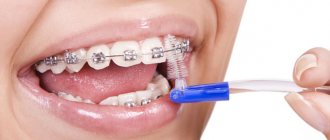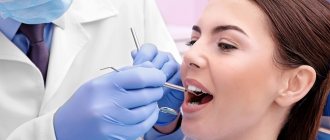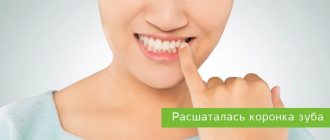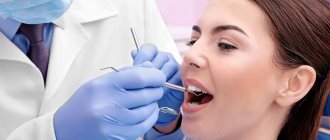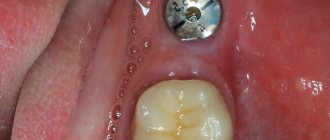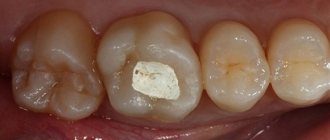Dental braces - what are they, what are they for, in what cases should they be installed? The design has gained enormous popularity over the past decades. Firstly, this treatment is effective; in a short period of time you can get straight teeth and enjoy a dazzling smile in the mirror. Secondly, there are many types of corrective elements to suit every taste and budget. Thirdly, it is possible to correct orthodontic problems at different ages. Even complex anomalies of the dentofacial apparatus can be corrected.
Let's consider what violations are eliminated in this way, how much time and money it will take.
Dental braces: what are they?
The design consists of brackets made of metal, ceramics or other materials. The system is attached to the outside or inside of the jaws. All elements are held on a special thin wire.
An orthodontic apparatus is necessary to eliminate pathologies that are associated with incorrect position of teeth. People mistakenly believe that the main purpose of such intervention is the aesthetic appeal of a smile. Doctors do not agree with this and argue that the curvature of incisors, canines and molars is primarily a medical problem, since it often leads to health problems. Food is not crushed enough when chewed, and then poorly digested, as a result of which diseases of the gastrointestinal tract develop.
There are other pathological processes that can only be dealt with with the help of staples. In some cases, extraction is required before installation.
How does the installation work?
Fixation takes a little time. First, the dentist must carry out professional oral hygiene. During this procedure, an ultrasonic scaler is used, which quickly and atraumatically cleans crowns of soft plaque and hard stones.
The second stage is taking impressions. Based on them, plaster models are made.
The third step is trying on the finished system. The doctor selects the optimal degree of arch tension, then hands the device back to the dental technician.
The final stage is re-fitting and installation of the mechanism. The brackets are placed on the supporting molars using metal locks.
Afterwards, the patient immediately goes home and continues to lead his usual lifestyle. In the first three to seven days he will be plagued by unpleasant sensations. Saliva will begin to flow profusely. This is due to the body's attempts to remove the foreign body from the oral cavity. Pain in both jaws is also possible. It is explained by the fact that the bracket puts pressure on the teeth, causing them to shift.
Why put them
Orthodontic elements are installed for many anomalies. These include crowding, diastema, incorrect placement of crowns and other disorders.
Bite correction
Why do they make, put on and wear braces when the teeth are in the wrong position? In this case, the structure of the dentition is disturbed. One of the jaws may be underdeveloped or extend far forward. A person has pronounced facial asymmetry; he cannot fully close the upper and lower elements of the maxillofacial apparatus.
Treatment lasts at least a year. In addition, a recovery period is subsequently indicated to consolidate the results. Stages:
- Preparation (from 2 days to a week). The duration depends on the condition of the oral cavity.
- Installation of an orthodontic arch. The period can be anything from several months to 2-3 years. The question is decided by the doctor based on the degree of neglect of the pathology.
- Recovery. Sometimes this may require as much as was spent on the correction itself.
Correcting crowding
When there is not enough space in the mouth, the units overlap each other. Due to lack of space, crowns become curved and change their natural position. What does this lead to:
- the appearance of carious cavities due to difficult hygiene, plaque accumulation and stone growth;
- periodontitis and other dental diseases;
- the occurrence of bad breath, which cannot be eliminated using special rinses and pastes;
- traumatic effects on individual parts of the jaw, resulting in destruction of periodontal fibers;
- formation of abscesses, fistulas and other inflammatory formations;
- inflammation of the submandibular lymph nodes.
Diastema correction
Wide gaps between adjacent teeth are a common problem. The anomaly can be symmetrical or asymmetrical. In the first case, the incisors, canines and molars are displaced from the center at equal intervals. In the second, one crown moves away more than the others.
Consequences of the pathology:
- diction disorders;
- whistling when pronouncing vowels and loud exclamations;
- instability to external influences;
- the appearance of complexes due to the aesthetic unattractiveness of the defect.
Varieties
Staples vary in scope, material of production, shape, and size. Each type has its own disadvantages and advantages, which affects the results of orthodontic treatment.
By area of application, staples are as follows:
- for correction of crooked bite;
- to return individual teeth to their place (it is possible to move units in relation to the horizontal and vertical plane, around their own axis);
- to eliminate crowding;
- to increase the volume of the palate.
If we talk about the method of fixation and the peculiarities of location in the oral cavity, then here are the corrective mechanisms:
- Lingual. Attached to the inner surface of the teeth. Visually similar to retainers. They treat malocclusion slowly, but do not spoil the smile. Such devices are chosen by public people, as well as people who tend to have complexes because of their own appearance.
- Vestibular. Placed in front of the teeth. They act faster than lingual ones, but change the smile for the worse. Quite large, which can cause problems with diction (especially in the first weeks of therapy).
What is dangerous about malocclusion?
When answering the question in what cases it is necessary to install braces and why this is necessary, it is worth familiarizing yourself with the consequences of ignoring the pathological process. Many people mistakenly believe that the lack of timely intervention only affects the patient’s appearance, so it is not so important whether to leave everything as is or still resort to the help of a professional orthodontist.
What will happen if you don't fix it?
What do these anomalies lead to:
- problems with the speech apparatus;
- difficulty swallowing, chewing food;
- disorders of the gastrointestinal tract;
- headaches, migraines;
- diseases of the musculoskeletal system;
- loosening and loss of incisors, canines, molars;
- frequent oral infections.
Pros and cons of braces
The system has many advantages. The main ones:
- Quickly fix the problem. To achieve the desired effect, long-term treatment is not necessary; the dental units take the correct position in a short period of time. This especially applies to structures made of metal.
- Many indications when the use of staples is applicable. These include both minor deviations and severe malocclusions that do not require surgical intervention.
- Possibility to combine with other therapeutic methods. Correction is applied individually or in combination, it all depends on the individual characteristics of the patient and the severity of the pathological process.
Flaws:
- External systems are visible to the naked eye. Even if you choose the most aesthetic options, they will still be noticeable to others. However, nowadays, orthodontic appliances have become a fashionable accessory, which indicates that the owner cares about his health. There are also lingual braces, hidden and unnoticeable.
- More careful oral hygiene is required. If you do not devote enough time to care, plaque will begin to accumulate and tartar will form. Professional cleaning in a dental office is recommended at least 3 times a year.
- Possibility of injury to mucous membranes (tongue, inner cheeks, gums). In the first time after installation, this phenomenon is not uncommon. But patients get used to the discomfort. In addition, you can purchase special wax to seal traumatic elements.
- Diet restrictions. This diet involves avoiding hard, viscous and sticky foods. Otherwise, the structure will quickly become unusable, and the duration of therapy will increase significantly.
When you can and cannot wear braces
The use of the system is indicated for malocclusion, crowding, and diastema. People of any age can be treated in this way. There are some restrictions for pregnant women, patients with implants, etc.
Who is contraindicated for installing arches:
- persons with acute immunological and neuropsychiatric diseases;
- patients with diseases associated with blood clotting;
- people with bruxism, serious gum pathologies;
- if you are allergic to metal or other materials used.
At what age is it better to get braces?
In adolescents aged 13-18 years, the dentition is most susceptible to various changes, so this time is optimal. The treatment will be much faster and painless. However, the structures can also be installed in patients of other age categories.
Malocclusion in children becomes noticeable even when the milk lines appear. Parents should take the child to a pediatric orthodontist so that the doctor can decide whether to install a corrective device. However, before the 12th birthday, there is a high probability of damage to the enamel layer. In addition, pathological changes in insufficiently formed roots are possible, which threatens the loss of incisors, canines and molars. Criteria by which children’s readiness for therapy is determined:
- sufficient enamel strength;
- suitable length of the coronal part;
- presence of anterior molar units.
Some people mistakenly believe that braces are useless for adults. Doctors note that the system can be used until the rows are completely healthy. However, there are some nuances here. The jaws are formed and are no longer so pliable, so the treatment will take a long time. In some cases, removal is required. In adulthood, various problems appear (caries, gum inflammation, thinning of hard tissues), which must be eliminated before the intervention of an orthodontist.
Content:
- Differences between dental braces and braces
- Indications for use
- Contraindications
- Varieties
- Braces for children
- At what age is it best to use braces?
- How does the installation work?
- System care
When correcting malocclusion in adults and children, braces are often used. Compared to braces, they are removable, but you have to wear them longer. Visually, such leveling systems resemble wire arches running along the entire dentition.
What do you need to get braces?
First of all, a visual examination is prescribed and diagnostic methods are determined. A treatment plan is then developed. Before installation, oral cavity sanitation, professional reading and other hygienic procedures are carried out. After which the structure is fixed.
How much does it cost
The cost may vary significantly. It depends on the type of system, material, as well as the severity of the pathology. For detailed information, we recommend contacting the dentist by phone listed on the website or leaving a request.
How to install braces if you have implants and crowns
Most patients who turn to orthodontists are adults between 25 and 45 years old. In addition to dental problems, they may have individual units removed and restoration elements may be present. The possibility of installing staples depends on the clinical picture in a particular case.
Inlays and veneers are not a contraindication. However, it is sometimes quite difficult to attach corrective parts to them, so therapy may not give much results.
Locks are also fixed onto artificial crown parts when only the root remains of the unit. If major correction is not required, the restored incisor, canine or molar may not be connected to the system. Experts recommend installing temporary plastic or composite crowns before treatment. They are inexpensive and can be removed if necessary.
If there is an implant, installation of brackets is either undesirable or completely contraindicated. The pin cannot be moved, otherwise it will be rejected by soft tissues. If you leave it in a static position, the remaining units will not be able to move. Thus, therapy is permissible in rare cases when the implanted element does not interfere with the correction of the bite.
Braces and pregnancy - compatible or not
While carrying a child, planning such treatment is strictly not recommended. This is primarily due to the need to undergo X-ray examination (CT, etc.), which is contraindicated in an “interesting position.” In addition, in the first days after installation, to speed up the adaptation process, it is recommended to take painkillers, which is unacceptable for pregnant women.
If therapy has begun and the woman sees two lines on the test, there is no need to remove the staples. However, in this case, you must adhere to the following rules:
- take good care of the oral cavity;
- undergo regular preventive cleaning with a doctor;
- carry out sanitation (preferably before installing braces and pregnancy);
- have the latest X-ray images available to track the dynamics of the correction.
Despite the limitations and undesirability of therapy during gestation, there are obvious advantages of such an intervention:
- in a woman, the structure of the bone tissue changes, and the units shift quickly;
- there is enough time for hygiene procedures;
- you can choose unaesthetic, but the most effective metal accessories, since for a long time you will not have to speak in public and be embarrassed.
How long should you wear braces?
The duration of treatment is determined by the doctor based on the diagnostic results, depending on the severity of the pathology and the selected type of structure. Each case is considered individually; there are no general recommendations.
It is important to remember that before installation it is necessary to get rid of gingivitis, caries, stomatitis and other problems. Therapy lasts at least a year; a shorter period is not enough. There is no maximum limit; some will have to wear braces for several years.
Can braces not help?
Wearing the system gives excellent results. If the dental units begin to diverge again, it means the patient did something wrong. Perhaps the doctor made mistakes at the diagnostic stage.
After therapy, wearing retainers (guards) is indicated. If this is not done, the incisors, canines and molars will quickly return to their previous position.
An important factor is the experience and professionalism of the orthodontist. If there is no positive effect, it is better to change the treating specialist. There are other reasons:
- unsuitable arc type;
- anatomical features of the structure of teeth;
- insufficient period of intervention.
What to do if braces don't help
Having discovered that wearing the structure turned out to be ineffective, you must first understand why this happened. When the system is dismantled, and the patient does not wear retainers (mouthguards) due to damage, loss, or does not even know that this should have been done, it is worth contacting the treating orthodontist. He will select the appropriate accessory. However, this applies to cases when no more than 2-3 days have passed since the removal of the structure. If a longer period has passed, the staples are reinstalled. The re-treatment will take less time than the first time, but it will last until the rows are aligned again.
If the doctor’s qualifications are weak, it is better to turn to another. Tactics depend on the factors that led to the problem.
Making a choice
Many people don't know which dental braces to choose. There is no need to rack your brains over this, as your doctor will help you make the right choice. To do this, he will take into account the characteristics of your oral cavity, age, and your wishes. Based on this, he will decide what to choose and offer it to you.
There are different types of brace systems, and you need to choose the right one based on the duration of treatment and other factors. So, if you plan to wear structures for a long time, it is better to choose ceramic or metal types. If you need to adjust your teeth slightly, you can choose sapphire ones. However, it is worth keeping in mind that this material is quite fragile, so if it is worn incorrectly, it may chip. In this case, you should immediately contact your dentist.
Do I need to take care of my teeth after braces?
During treatment, careful oral hygiene is indicated. Rinsing and brushing should be done every time after eating, including snacks. This way the patient gets rid of food particles in the interdental spaces and on the enamel surface.
It is better to use a brush with soft bristles and a small amount of fluoride toothpaste. There are special rinses and flosses (threads) for better care.
When the system is dismantled, the person needs to wear mouthguards (retainers). This consolidates the result obtained. If the aligned units are not maintained, they will soon return to their previous position.
After therapy, the enamel becomes thinner and more vulnerable. Doctors perform remineralization (fluoridation). Plaque and stone are first cleaned off.
To maintain oral health, it is necessary to visit the dentist regularly for preventive examinations. A beautiful smile will last for many years if you regularly care for the soft and hard tissues in your mouth (clean in the morning and evening, after meals, use an irrigator).
Rules of care
Because braces trap food particles during chewing, careful oral hygiene is necessary. At the appointment, the orthodontist explains in detail how to clean the teeth when wearing appliances.
Some rules:
- use a special brush for cleaning;
- clean your teeth with an irrigator;
- rinse your mouth every time after eating and even a light snack;
- preventively disinfect the oral cavity with medicinal balms and herbal infusions.
During dental correction, it is prohibited to use chewing gum or eat sticky candies such as “Iris” and lollipops. You'll have to give up chips and crackers.
Herbal rinse
To prevent inflammatory processes in the gums, you need to regularly rinse your mouth with herbal infusions or medicinal balms. Good herbal remedies to help prevent and eliminate inflammation include:
- aloe vera;
- echinacea;
- calendula;
- eucalyptus;
- goldenseal.
Herbs soothe irritated mucous membranes and stimulate local immunity. Echinacea is especially indicative in this case. For a pleasant aroma and fresh breath, use mint tincture or mint tea.
If pain appears in the mouth, the herbs sage, chamomile and St. John's wort will help relieve inflammation. For gum pathology, tea tree essential oil is used - applications, massage.
Rinse with antiseptics
Among pharmaceutical products are drugs with antibacterial and antiseptic properties. These include:
- furatsilin;
- miramistin;
- chlorhexidine.
However, long-term use of chlorhexidine causes the enamel to turn yellowish, so it is necessary to alternate the products with each other.
Home remedies for caring for mucous membranes and teeth include a soda solution. It is enough to dilute a coffee spoon in a cup of warm water.
You should rinse with an antiseptic solution after every snack - this is prevention. If inflammation occurs, rinse is used every 1.5-2 hours. Braces can negatively affect the condition of the mucous membrane, so if discomfort occurs, go to the dentist immediately.
Herbs not only effectively remove plaque on enamel, but also fight bacteria and strengthen local immunity. It is advisable to prepare herbal infusions daily, and not use yesterday’s or the day before yesterday’s.
Let's sum it up
The question of why adults need to get braces on their teeth disappears when the patient becomes familiar with the possible consequences of malocclusion. There are many designs that differ in appearance, material of manufacture, visibility to others, cost and other characteristics. Before settling on a specific option, it is necessary to undergo diagnostic tests and consult with an orthodontist. It is likely that wearing the system in a particular case may be contraindicated, so you need to carefully consider the preparatory measures and listen to the opinions of various highly qualified specialists.
For children
Our dental prosthetics and orthodontics clinic installs braces not only for adults and teenagers, but also for young children. Which system is best to choose for your child? Usually a system is installed that consists of 20 “locks”. One half is attached at the top, the other at the bottom. Orthodontics considers this treatment to be the most effective. Metal structures are shown for children. After a few years, the braces are replaced with other, more advanced ones, for example, ceramic ones.
